The technique of “Tamba ware” has been passed down in Sasayama for over 850 years. Its origins date back to the late Heian (11th – 12th century) and early Kamakura periods (late 12th century – early 13th century). It is recognized as one of the “Six Ancient Kilns of Japan”.
Tamba ware was originally developed for day-to-day use, including vessels for water storage, sake flasks (tokkuri), and tableware. Initially, utilitarian wares such as pots, jars, and mortars predominated. However, during the early Edo period (17th century), there was an emergence of works considered “masterpieces”, specifically crafted for the Japanese tea ceremony. These included tea caddies, cold water containers, and tea bowls. In the late Edo period, under the protection and cultivation by the Sasayama clan, master potters like Naosaku, Ichifusa, Kayuu and Ichikono competed in their skills, contributing to the widespread recognition of Tamba ware.
Since then, with shifting times, the current emphasis has returned to the production of tableware, flower vases, and other folk crafts (mingei).
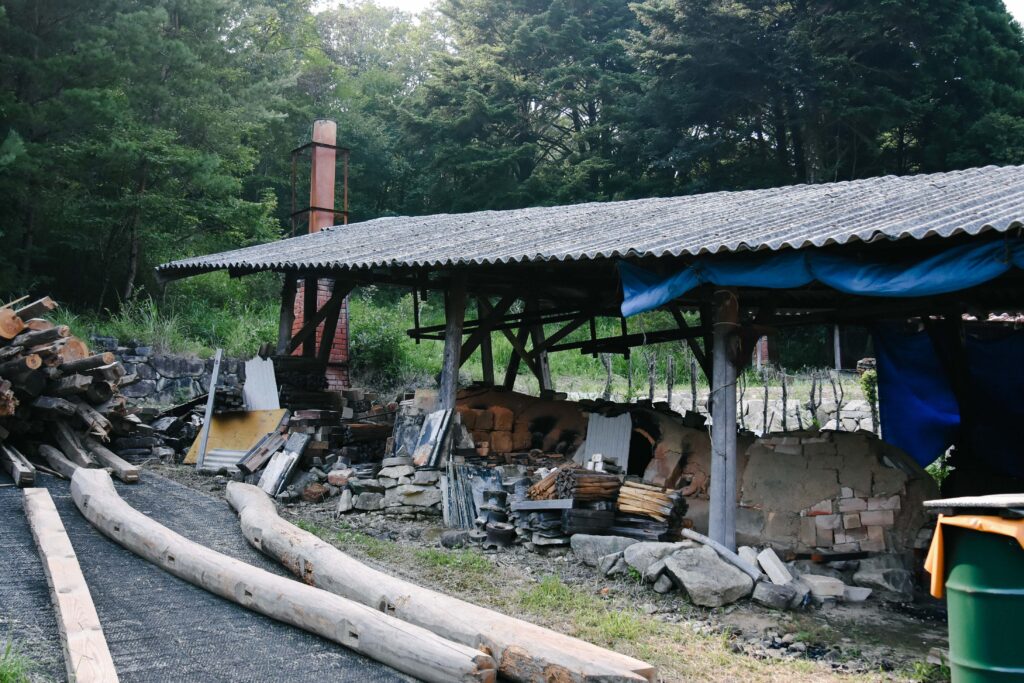
The climbing kiln at the back of Tansui-gama Pottery has been in operation since it was relocated there in the early 1990s
“Tansui-gama” is one of the leading potteries in the Tamba pottery tradition. Mr. Satoshi Tanaka works alongside his father at the pottery and succeeded him as the 7th-generation proprietor.
Mr. Satoshi grew up watching his grandfather and father making ceramics. After graduating from high school, he went to study art at a vocational school. He then deepened his understanding of glazes at a vocational training school in Kyoto before taking over the family business at the age of 24.
「From then on, it was a struggle of trial and error. What are my strengths? How could I develop my own distinctive style? As I didn’t have a master I had to think about what I should be aiming for by myself; I just kept on making pottery, all the while grappling with these questions.」

The direction a craftsperson takes in pottery depends on the type of work they wish to create, whether it involves making highly artistic works of art or functional ware for daily use. When Mr. Tanaka was a student, he decided to “make pottery for everyday use”. However, discovering the essence of his own distinctive style proved challenging. In this journey, he was deeply influenced by Mr. Kumaya of Utsuwa Studio, on Kyūshū Island.
Mr. Tanaka first encountered Mr. Kumaya when he participated in a pottery event held in Tokyo. He was drawn to the artist’s work which featured a technique called “Kohiki.” Intrigued by this technique, he asked about it and then began to incorporate this newly acquired knowledge into his subsequent pottery creations.
「Before meeting this artist I knew ‘I wanted to create something of worth’ but I only had vague ideas; he really helped me clearly articulate my goals. I could visualize how to demonstrate my strengths and what kind of pottery I can provide for my customers. Once I could envision that, ideas about materials and techniques started to flow naturally.」
Influenced by Mr. Kumaya, Mr. Tanaka makes pottery using the Kohiki technique. Kohiki is a style of pottery defined by the use of white slip prior to glaze-firing. This ware is traditionally distinguished by its warm, soft white color.
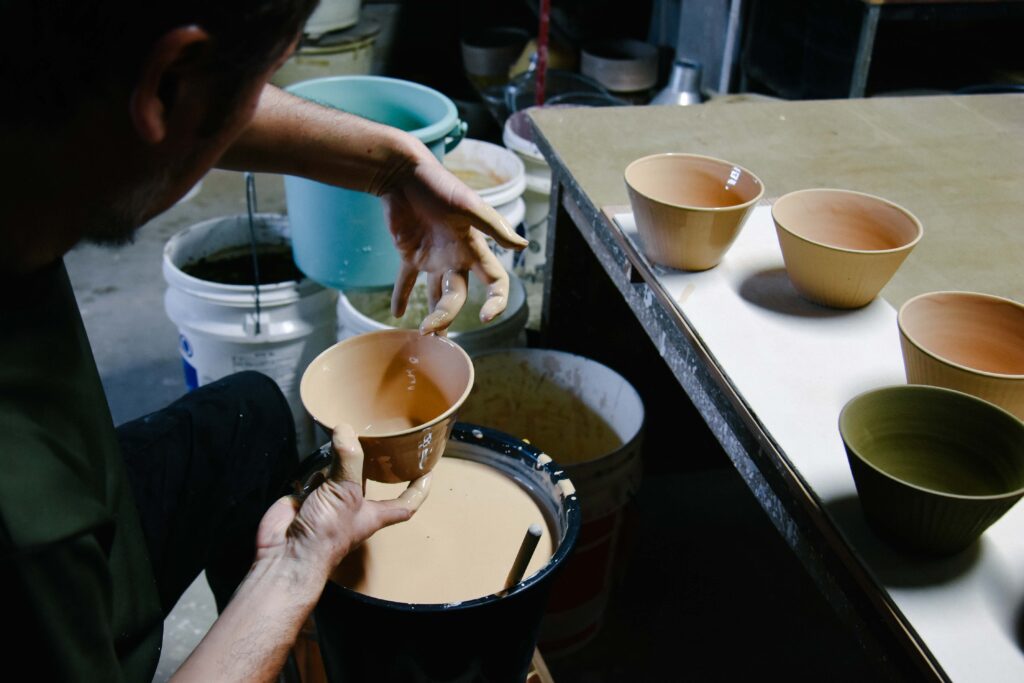
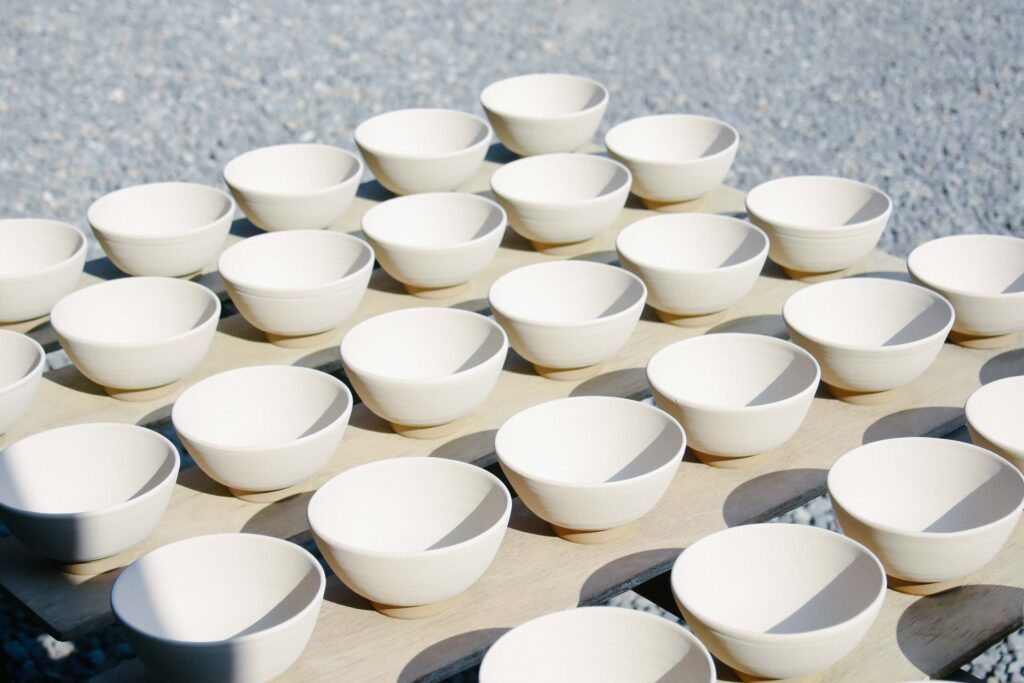
The white slip alters the visual impression of the clay surface
In Tamba ware, traditionally made by firing iron-rich clay in kilns fueled by pine wood, the finished surface often featured shades of brown or reddish-brown. Amid the prevalence of these darker tones, Mr. Tanaka introduces a softer color palette with Kohiki, creating functional ware with hues and textural characteristics distinct from that of conventional Tamba ware.
「I like Kohiki, partly because of its simplicity but also because I really like its softness. It is not difficult to make, and it’s one of the techniques that most potters have practiced at least once. I try to add my own essence to it so that I can bring out my originality.」
In addition to white, the Tansui-gama Pottery also produces tableware with variegated shades using colored glazes such as antique yellow and brown. What remains consistent is the method of applying the glazes. By building up the glaze in several thin layers, Mr. Tanaka is able to create many hues and shades within the same color range. The finished surface becomes mottled, giving the appearance of being softly textured.
While Mr. Tanaka’s vessels may appear textured, the experience of holding one reveals how smooth and pleasant they feel to the touch. And comfort in use is something that Mr. Tanaka values highly in his creations.
「We are also keen on making them as light as possible to ensure the comfort of use. For example, with cups, we make them thin and light to ensure that they are smooth to the lips when drinking from them. The larger the dish, the thicker it becomes, but if you make it as thin and light as possible, it will feel comfortable to the touch and to use.」
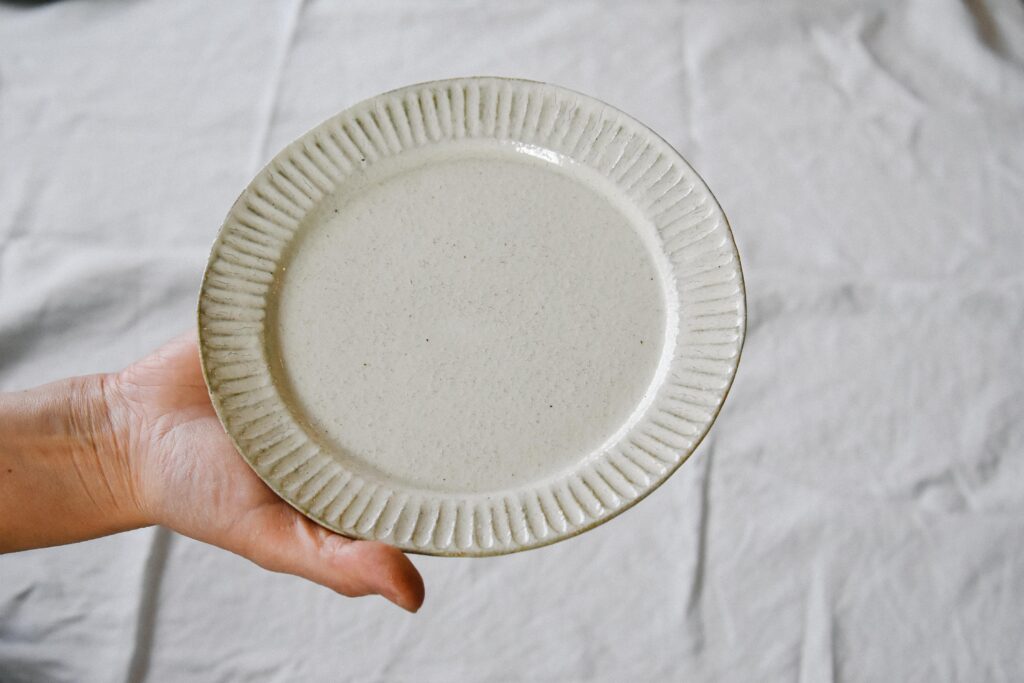
Mr. Tanaka says that it is also important to ensure that the strength and beautiful texture of the vessels remain intact so that people can continue to use them for a long time. While Kohiki can express soft colors, it is also delicate and fragile. So, it is necessary to devise ways to strengthen its fragility.
Additionally, stoneware has absorbent properties, inevitably leading to color changes over time due the effects of water and oil. This change can be more noticeable with white ware, making it difficult to maintain the original color.
Through trial and error, Mr. Tanaka has worked to address factors affecting usability, including fragility and susceptibility to stains.
「After all, the essence of a vessel lies in its use. Our vessels are made to be used everyday. To maintain their original condition for as long as possible, we put extra effort into our making process to make each vessel durable and resistant to stains. It may be challenging, but I believe it’s important to make vessels for customers that have longevity and become more comfortable to use over time. Of course, I think it’s nice to nurture and enjoy a vessels changing appearance but it’s also nice to be able to use them for longer without worry, retaining the look they had when first bought.」
Mr. Tanaka and TRUNK DESIGN produce the SOBACHOKO series in collaboration. These cups can be used as soba choko (buckwheat noodle cups) as well as for enjoying coffee or tea.
Mr. Tanaka and TRUNK DESIGN representative Yasuhiro Horiuchi met in 2018 when Mr. Horiuchi approached Mr. Tanaka after seeing his work at an event where they both had stalls.
Mr. Horiuchi asked Mr.Tanaka if he would be interested in producing the SOBACHOKO series in stoneware at his Tansui-gama Pottery. The SOBACHOKO series, created by TRUNK DESIGN, was initially produced in porcelain by Ojiyama Kiln Studios.
「I was also making soba choko on my own, but the design was different in terms of size and shape from the SOBACHOKO series. While working on it, I learned a lot. It’s interesting to have products made by different potters within the same series because you can feel the unique differences in each.」
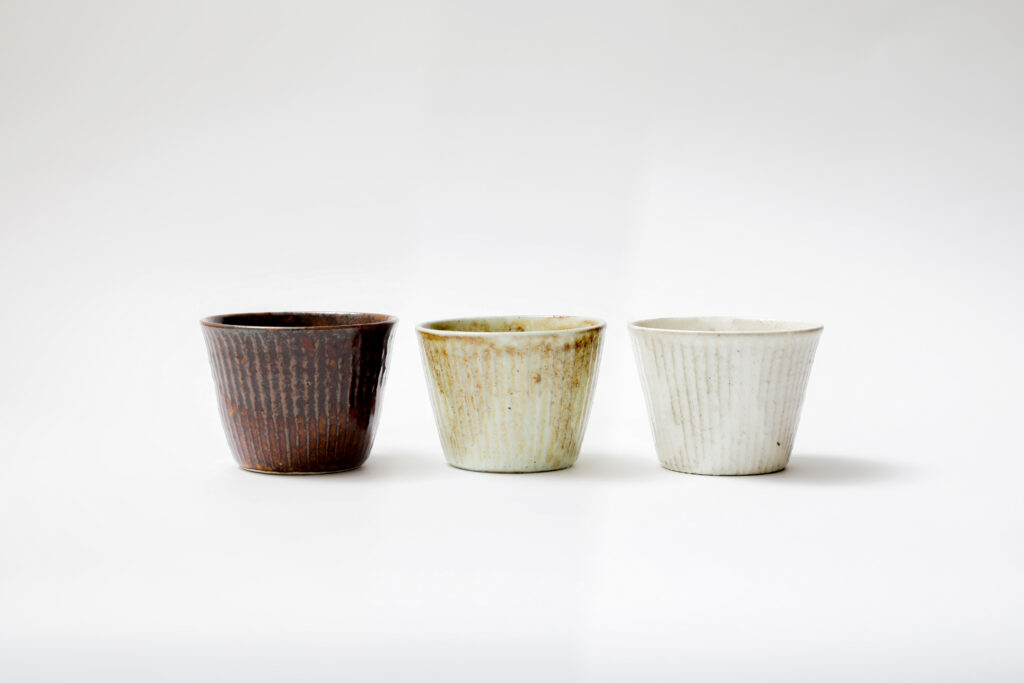
SOBACHOKO: Cups with a stackable and space saving design
It has been 25 years since Mr. Tanaka started making vessels, but it is only within the last decade that he has found his style of expression through use of the kohiki technique. With a clear idea of what he wants to achieve, he is enthusiastic about the future and hopes to connect his work to a wider audience.
「I want to make things that resonate with me without becoming self-satisfying. So it’s important to gauge the reaction of the people who pick up and feel my work, which I hope to introduce to a wider audience. The aim is to continue developing my style, while preserving its essence.」
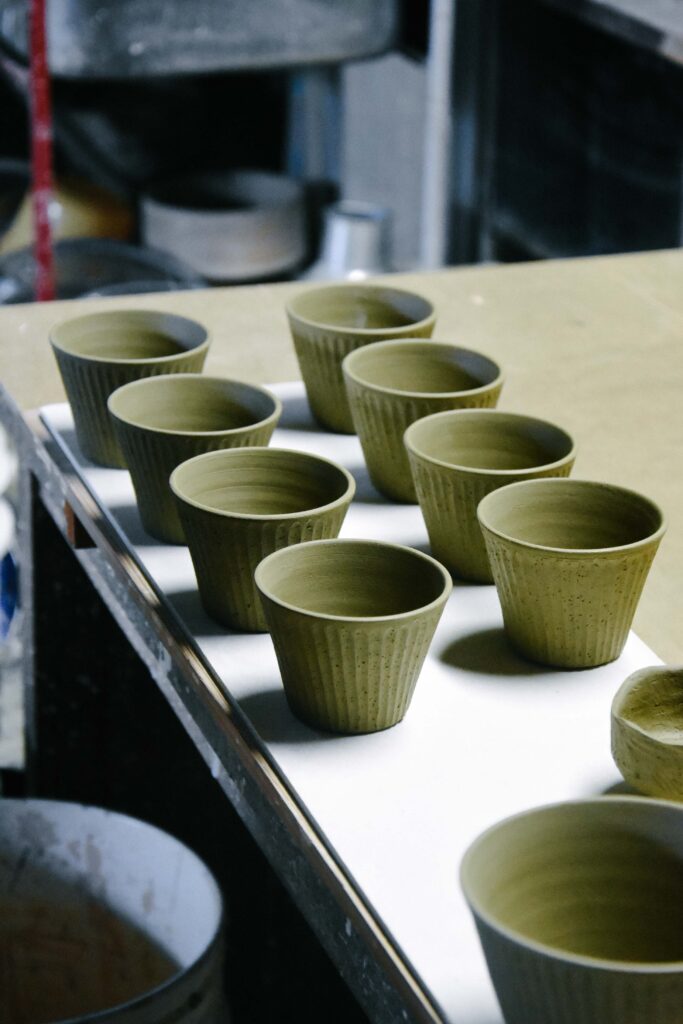
An important consideration for Mr. Tanaka when creating his vessels is whether or not he himself would want to use them. If a customer finds themselves picking up and using a vessel in everyday circumstances without realizing it, then he knows he has achieved his goal in pottery making.
「Sometimes you end up using the same utensils every day, don’t you? Is it because they are easy to use, or what? I want to make dishes that you never get tired of. When you have one simple, easy-to-use vessel, you can have all sorts of fancy other ones. I hope to make vessels that can be kept for everyday use and can be used over generations.」
Mr. Tanaka refines his work through trial and error. He is dedicated to the pursuit of creating a vessel that someone will instinctively reach out for. 「I think it’s interesting to think of the white surface as a blank canvas,」he remarks. Based on a style born from his own intuitive discoveries, Mr. Tanaka will continue to make vessels in his pottery, searching for simplicity and comfort of use, creating functional ware for a variety of dishes and for all occasions.
Direction and photography by TRUNK DESIGN Inc.
Editing: Takehiko Yanase
Text: Takumi Miyamoto